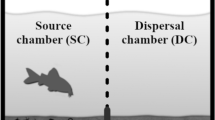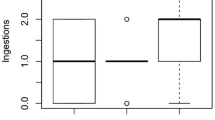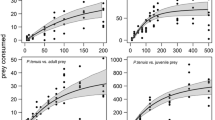Abstract
Catenulid turbellarians, common in shallow, tropical ponds, affect their rotifer prey via the production of toxins. There is, however, no quantitative information on their effect on the demography of their prey. Here, we test the impact of Stenostomum cf leucops on the population dynamics of the rotifers Euchlanis dilatata and Plationus patulus, and the cladoceran Moina macrocopa. Experiments were initiated with rotifers at 0.5 ind. ml−1 and the cladoceran at 0.2 ind. ml−1; growth patterns were compared in the absence and presence of worms (2 Stenostomum ind. per 50 ml). Results revealed that brachionids were most adversely affected: there was a lower growth rate of the rotifers in the presence of worms (P < 0.01, repeated measures ANOVA), although at the densities applied, the predator did not wipe out its prey. These littoral predators may therefore regulate rotifer prey in natural conditions. In Moina, the population evolved differently; initially, we found no difference between control and treatment, but after about 10 days, the population collapsed, irrespective of a direct or indirect contact with the predator. This delayed effect deserves more study, as it could represent flatworm toxin accumulation by the cladoceran.





Similar content being viewed by others
References
Altwegg, R., M. Eng, S. Caspersen & B. R. Anholt, 2006. Functional response and prey defence level in an experimental predator–prey system. Evolutionary Ecology Research 8: 115–128.
Blaustein, L. & H. J. Dumont, 1990. Typhloplanid flatworms (Mesostoma and related genera): mechanisms of predation and evidence that they structure aquatic invertebrate communities. Hydrobiologia 198: 61–77.
Borowitzka, M. A. & L. J. Borowitzka, 1988. Micro-Algal Biotechnology. Cambridge University Press, Cambridge: 480 pp.
Dumont, H. J., 1977. Biotic factors in the population dynamics of rotifers. Archiv für Hydrobiologie Beiheft 8: 98–122.
Dumont, H. J. & I. Carels, 1987. Flatworm predator (Mesostoma cf lingua) releases a toxin to catch planktonic prey (Daphnia magna). Limnology and Oceanography 32: 699–702.
Dumont, H. J. & S. S. S. Sarma, 1995. Demography and population growth of Asplanchna girodi (Rotifera) as a function of prey (Anuraeopsis fissa) density. Hydrobiologia 306: 97–107.
Felix, A., M. E. Stevens & R. L. Wallace, 1995. Unpalatability of a colonial rotifer, Sinantherina socialis, to small zooplanktivorous fishes. Invertebrate Biology 114: 139–144.
Fyda, J., A. Warren & J. Wolinska, 2005. An investigation of predator-induced defense responses in ciliated protozoa. Journal of Natural History 39: 1431–1442.
Garza-Mouriño, G., M. Silva-Briano, S. Nandini, S. S. S. Sarma & M. E. Castellanos-Páez, 2005. Morphological and morphometrical variations of selected rotifer species in response to predation: a seasonal study of selected brachionid species from Lake Xochimilco (Mexico). Hydrobiologia 546: 169–179.
Gilbert, J. J., 1998. Kairomone-induced morphological defenses in rotifers. In Tollrian, R. & C. D. Harvell (eds), The Ecology and Evolution of Inducible Defenses. Princeton University Press, Princeton: 127–141.
Iyer, N. & T. R. Rao, 1995. The epizoic mode of life in Brachionus rubens Ehrenberg as a deterrent against predation by Asplanchna intermedia Hudson. Hydrobiologia 313–314: 377–380.
Iyer, N. & T. R. Rao, 1996. Responses of the predatory rotifer Asplanchna intermedia to prey species differing in vulnerability: laboratory and field studies. Freshwater Biology 36: 521–533.
Kerfoot, W. C. & A. Sih (eds), 1987. Predation: Direct and Indirect Impacts on Aquatic Communities. University Press of New England, Hanover, NH.
Kolasa, J., 2001. Flatworms: Turbellaria and Nemertea. In Thorp, J. H. & A. P. Covich (eds), Ecology and Classification of North American Freshwater Invertebrates. Academic Press, New York: 145–172.
Koste, W., 1978. Rotatoria. Die Rädertiere Mitteleuropas. Ein Bestimmungswerk begründet von Max Voigt, Vol. 1, Textband: 673 pp; Vol. 2, Tafelband: 234 pp. Bornträger, Stuttgart.
Kratina, P., M. Vos, A. Bateman & B. R. Anholt, 2009. Functional responses modified by predator density. Oecologia 159: 425–433.
Krebs, C. J., 1985. Ecology: The Experimental Analysis of Distribution and Abundance, 3rd ed. Harper and Row, New York.
Murdoch, W. W. & J. Bence, 1987. General predators and unstable prey populations. In Kerfoot, W. C. & A. Sih (eds), Predation: Direct and Indirect Impacts on Aquatic Communities. University Press of New England, Hanover, NH: 17–30.
Nielsen, D. L., F. J. Smith, T. J. Hillman & R. J. Shiel, 2000. Impact of water regime and fish predation on zooplankton resting egg production and emergence. Journal of Plankton Research 22: 433–446.
Noreña, C., C. Damborenea & F. Brusa, 2005. A taxonomic revision of South American species of the genus Stenostomum O. Schmidt (Platyhelminthes: Catenulida) based on morphological characteristics. Zoological Journal of the Linnaean Society 144: 37–58.
Nuttycomb, J. W. & A. J. Waters, 1935. Feeding habits and pharyngeal structure in Stenostomum. Biological Bulletin 69: 439–446.
O’Brien, W. J., 1987. Planktivory by freshwater fish: thrust and parry in the pelagia. In Kerfoot, W. C. & A. Sih (eds), Predation: Direct and Indirect Impacts on Aquatic Communities. University Press of New England, Hanover, NH: 3–16.
Sarma, S. S. S. & S. Nandini, 2007. Small prey size offers immunity to predation: a case study on two species of Asplanchna and three brachionid prey (Rotifera). Hydrobiologia 593: 67–76.
Sarma, S. S. S., R. D. Gulati & S. Nandini, 2005. Factors affecting egg-ratio in planktonic rotifers. Hydrobiologia 546: 361–373.
Serrania-Soto, C. & S. S. S. Sarma, 2009. Morphometric changes in Lecane stokesii (Pell, 1890) (Rotifera: Lecanidae) induced by allelochemicals from the predator Asplanchnopus multiceps (Schrank, 1793). Allelopathy Journal 23: 215–222.
Wallace, R. L., T. W. Snell, C. Ricci & T. Nogrady, 2006. Rotifera Part 1: Biology, Ecology and Systematics. Guides to the Identification of the Microinvertebrates of the Continental Waters of the World. Kenobi Productions Gent/Backhuys, The Netherlands.
Weber, C. I., 1993 Methods for Measuring the Acute Toxicity of Effluents and Receiving Waters to Freshwater and Marine Organisms, 4th ed. United States Environmental Protection Agency, Cincinnati, OH, EPA/600/4-90/027F, xv + 293 pp.
Acknowledgments
We thank Dr. J. Kolasa for identifying the flatworm. The first two authors thank National Autonomous University of Mexico (DGAPA–PASPA) for financial support.
Author information
Authors and Affiliations
Corresponding author
Additional information
Guest editors: N. Walz, R. Adrian, J.J. Gilbert, M.T. Monaghan, G. Weithoff & H. Zimmermann-Timm / Rotifera XII: New aspects in rotifer evolution, genetics, reproduction, ecology and biogeography
Rights and permissions
About this article
Cite this article
Nandini, S., Sarma, S.S.S. & Dumont, H.J. Predatory and toxic effects of the turbellarian (Stenostomum cf leucops) on the population dynamics of Euchlanis dilatata, Plationus patulus (Rotifera) and Moina macrocopa (Cladocera). Hydrobiologia 662, 171–177 (2011). https://doi.org/10.1007/s10750-010-0493-3
Published:
Issue Date:
DOI: https://doi.org/10.1007/s10750-010-0493-3




